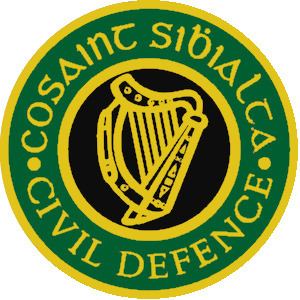Formation 1950 Region served Ireland Website civildefence.ie | Legal status Active Leadership Civil Defence Board | |
 | ||
Headquarters Roscrea, County Tipperary, Ireland | ||
Civil Defence Ireland (Irish: Cosaint Shibhialta na hÉireann) is the national civil defence organisation of Ireland. It is operated at local authority level in conjunction with the Department of Defence.
Contents
The organisation was established in 1950 in response to the threat of nuclear disaster posed by the atomic bomb following World War II or "The Emergency" as World War II was known in Ireland. Its purpose was to provide aid, assistance and disaster relief to citizens in time of emergency. Today, the organisation runs on the same principle with a focus on effectively aiding the full-time emergency services as and when required.
Organisation Structure
Civil Defence Ireland is composed almost entirely of volunteers, with the exception of the local authority-appointed Civil Defence Officers, Assistant Civil Defence Officers, administration, maintenance and stores personnel. The organisation provides five different services to the community, primarily acting as an auxiliary resource for the front-line emergency services, particularly the fire brigade rescue and ambulance service who may utilise the organisation's manpower, skills and equipment when requested.
Civil Defence Ireland - Rank Structure
Vehicles
The organisation uses many different types of vehicles. Some are purpose-built and some have been adapted into new roles such as mobile incident command units. Many of the vehicles have all-terrain capabilities such as Land Rover Defender field ambulances, Bedford and Iveco four-wheel drive lorries and Bandvagn 206 personnel carriers. Standard vehicles such as emergency ambulances and class B fire appliances are also available for use by their respective services. Vehicle livery is generally non-standardised orange and blue on a white background with the exception of Dublin Civil Defence who use fleet-standard orange/blue Battenburg markings over white paintwork on all new vehicles. The Water Rescue Unit have a fleet of inshore patrol vessels and rigid-hulled inflatable boats.
Uniforms
Following a redesign of the uniform in recent years there are now two main standard configurations of uniforms within the organisation, namely the Workwear No. 2 Uniform and the Service Dress No. 1 Uniform. All members of the organisation are issued with the standard Workwear No. 2 Uniform consisting of:
Also as a change from the normal practice within some areas of the organisation, instructions now clearly outline such uniform rules as "Badges/Decorations or any other items CANNOT be worn or attached to any item of the Workwear Uniform i.e. shirt, t-shirt, waterproof jacket, soft shell jacket."
The No.1 Dress Uniform, is worn at certain occasions under the direction of the local Civil Defence Officer. The core components of the No. 1 Dress Uniform are:
These core components are supplemented by some additional components for particular occasions such as White Gloves, White belt etc. as directed by the Civil Defence Officer.
While these are the main two configurations of uniforms there are also a number of other configurations for different specialist areas. For example members of the Auxiliary Fire Service are issued with firefighting jackets/trousers, gloves, fire boots and firefighter's helmets. Members of the rescue service wear a jumpsuit and safety boots/helmets. Members of the Water Rescue Unit are issued with drysuits, water rescue helmets and Personal Flotation Devices (PFDs).
Notable emergency calls
The Civil Defence can be activated by request from civil power (gardaí), local authority, fire services and the Health Service Executive. The organisation may also respond to incidents witnessed in active duty such as road traffic collisions. They may also respond to non-statutory requests at the discretion of the Civil Defence Officer.
Selected notable events in the organisation's history are:
Civil Defence College
The Civil Defence College was initially based at Ratra House in Dublin's Phoenix Park before relocating to Roscrea, County Tipperary in 2006. The college is housed within the national headquarters of Civil Defence and serves to provide potential instructors with a level of education that will allow them to teach classes of volunteers to be competent in their service's skills. Courses include AFS Instructor, Radio Communications Operator/Instructor, Emergency First Responder and Emergency Medical Technician. The college is approved by the Pre-hospital Emergency Care Council (PHECC) to train members to practitioner (EMT) level and is approved to implement the 3rd edition Clinical Practice Guidelines (CPGs) set down by PHECC.
